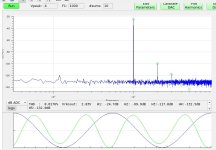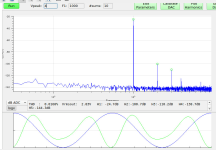Based on the circuit shown by Papa at the BAF 2023, I have built the F5m using easily modified DIYAudio Store F5 boards from long ago. I installed the boards on my prototyping chassis configured to handle the FirstWatt standard +/-24V power and a subset of the Universal Mounting Spec heatsink holes.
Since my heatsinks are fairly large (7" tall Heatsink USA 10.080" wide C/W/3": approximately .80), I biased the output FETs at around 1.35A, giving a heatsink temperature rise of 23C.
The distortion measurements are consistent with what Papa showed in the BAF 2023 video presentation.
The damping factor measured at around 26.
How does it sound? Amazing for such a simple amplifier with A/B listening against more powerful and lower distortion amplifiers. Plenty of power for my 88dB sensitivity speakers in rather large room.
Hats of to Papa, the circuit magician.



Since my heatsinks are fairly large (7" tall Heatsink USA 10.080" wide C/W/3": approximately .80), I biased the output FETs at around 1.35A, giving a heatsink temperature rise of 23C.
The distortion measurements are consistent with what Papa showed in the BAF 2023 video presentation.
The damping factor measured at around 26.
How does it sound? Amazing for such a simple amplifier with A/B listening against more powerful and lower distortion amplifiers. Plenty of power for my 88dB sensitivity speakers in rather large room.
Hats of to Papa, the circuit magician.






